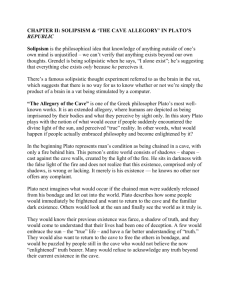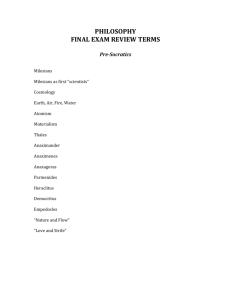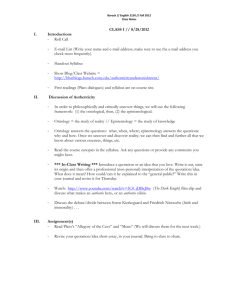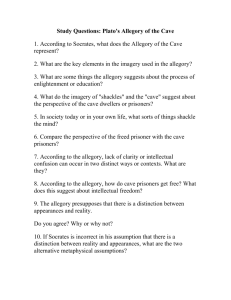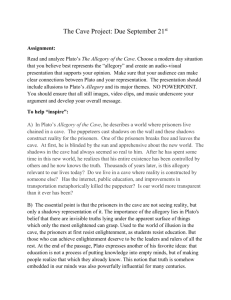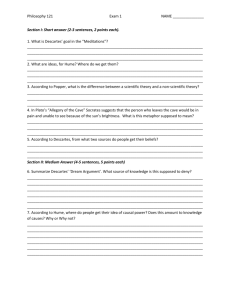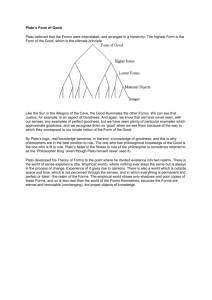What is Philosophy Final Paper
advertisement
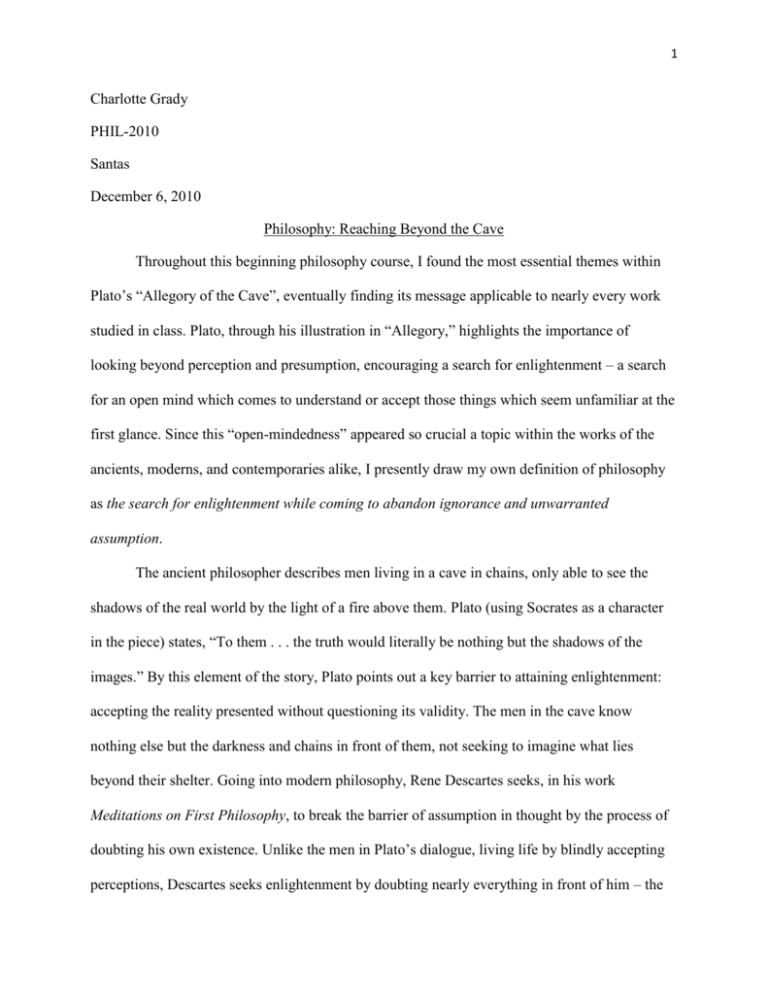
1 Charlotte Grady PHIL-2010 Santas December 6, 2010 Philosophy: Reaching Beyond the Cave Throughout this beginning philosophy course, I found the most essential themes within Plato’s “Allegory of the Cave”, eventually finding its message applicable to nearly every work studied in class. Plato, through his illustration in “Allegory,” highlights the importance of looking beyond perception and presumption, encouraging a search for enlightenment – a search for an open mind which comes to understand or accept those things which seem unfamiliar at the first glance. Since this “open-mindedness” appeared so crucial a topic within the works of the ancients, moderns, and contemporaries alike, I presently draw my own definition of philosophy as the search for enlightenment while coming to abandon ignorance and unwarranted assumption. The ancient philosopher describes men living in a cave in chains, only able to see the shadows of the real world by the light of a fire above them. Plato (using Socrates as a character in the piece) states, “To them . . . the truth would literally be nothing but the shadows of the images.” By this element of the story, Plato points out a key barrier to attaining enlightenment: accepting the reality presented without questioning its validity. The men in the cave know nothing else but the darkness and chains in front of them, not seeking to imagine what lies beyond their shelter. Going into modern philosophy, Rene Descartes seeks, in his work Meditations on First Philosophy, to break the barrier of assumption in thought by the process of doubting his own existence. Unlike the men in Plato’s dialogue, living life by blindly accepting perceptions, Descartes seeks enlightenment by doubting nearly everything in front of him – the 2 senses – to eventually recreate a new idea of life. Descartes begins to call into doubt all past beliefs, realizing the deception of senses, the possibility of living life through dreams, and the possibility of an all-powerful evil deceiver (one who manipulates to make certain ideas appear factual). Above all, Descartes doubts to find what absolutely cannot be doubted, seeking a foundation for a new way of thinking. Eventually the he finds this foundation, using deductive reasoning to prove two certainties: that he exists and that he thinks. Initially realizing the possibilities of living in a cave-like existence as in Plato’s allegory, Descartes takes his first step away from ignorance and dependence on perception alone by questioning his own “cave,” beginning a new path to enlightenment by the certainty of his own existence and thought. By this foundation, Descartes finds new explanations for the existence of God, the limits of human understanding, and the infinite possibility of human free will. Plato’s allegory demonstrates the idea of abandoning ignorance by specifically focusing on the difficulty in leaving a comfort zone and an unchallenging existence. In today’s society, a particular problem lies within the unwillingness to accept another point of view, a refusal to branch out into new ways of thought or accept people experiencing a different life-style from their own. Plato illustrates, “When any of them is liberated and compelled suddenly to . . . look toward the light, he will suffer sharp pains; the glare will distress him, and he will be unable to see the realities of which his former state he had seen shadows.” Being so blinded by ignorance during their entire existence, getting pushed into truth brings pain and discomfort to the men in chains. The liberated prisoner in the allegory parallels man’s inability to readily accustom to new ways, failing to become open-minded without initially shutting out unfamiliarity. Bell hooks, in Teaching to Transgress, vies for the acceptance and acknowledgement of diversity within the contemporary classroom, calling for a change in school systems’ focus on upper-to-middle class 3 white Americans as education’s main target. Making a strong transition in her classroom by acknowledging race, sex, and class, hooks reports on her early experience, “I saw for the first time that there can be, and usually is, a degree of pain involved in giving up old ways of thinking and knowing and learning new approaches. I respect that pain”(43). Like Plato, hooks boldly accepts the pain the path to an open-mind, to enlightenment, is difficult; hooks holds her focus on teaching students to accept and not ignore diversity and things unfamiliar, yet calls to challenge old ways of living. The latter part of my definition of philosophy, coming to abandon ignorance and unwarranted assumption remains a difficult task, full of steps and testing of character, proven by both hooks and Plato. In a section I find particularly intriguing in relation to the ancient allegory, hooks critically analyzes the overall fragmented history between white women and black women. Hooks writes that prejudices and jealousies and desire for power are passed from generation to the next, illustrating reasons for post-Civil War tensions between the two groups. With examples and reasons for the tensions spelled out, hooks ultimately claims that discussion and acknowledgement of the past can start to heal relationships between the two groups. In a sense, she calls the two groups to come out of their “caves” and move through the pain of being in the light together. In her writing hooks emphasizes the process of philosophy rather than an area of study. Philosophy is not enlightenment, but the search for it, and oftentimes a challenging and painful search which takes time. The last concept in Plato’s allegory deals with the aftermath of the discovery, after one man finds the way to enlightenment. Plato raises the question of what a man will do when faced with the decision to either bring his new knowledge back to the place of darkness or to keep the knowledge to himself and leave the majority in ignorance. Implications of persecutions come up in the allegory, as Socrates’ character claims, “men would say . . . that it were better not even to 4 think of ascending; and if anyone tried to loose another and lead him up to the light, let them only catch the offender, and they would put him to death.” Here the ancient philosopher presents a current issue in society regarding maintaining knowledge and the choice of taking action or succumbing to fear or discouragement. If one man knows the truth and does nothing, then the truth is futile. In my definition I stated that part of philosophy is coming to abandon ignorance, but if one man keeps the knowledge of enlightenment to himself and goes on living like the majority regardless of his experience, the ignorance will still linger within him due to fear. In a great example of issues in contemporary society, Daniel Quinn’s novel Ishmael: An Adventure of the Mind and Spirit examines the fictional interactions between a gorilla, a teacher, and man, a pupil. The novel covers the process of what I came to call philosophy, including the elements of doubt, pain coming with knowledge, and most notably, decisions on action or inaction. Quinn describes the gorilla acting as the man’s teacher, presenting the pressing issues of society’s lack of care towards the earth and man’s destruction of future generations. With these teachings, the man becomes burdened with knowledge – saddened by the truth of man’s destruction but discouraged by the means to go about bringing change in society on his own. After hearing the truth, the man cries out, “it’s a story you’ve got there, a story of hopelessness and futility, a story in which there is literally nothing to be done . . . all you can do is just watch it come”(89). While the truth pains the man, longing for a better world, his discouragement and assumption that mankind will never change keeps his pain from transforming into action. Yet as the Ishmael, the gorilla, progresses with his teachings, the man finds that any man like himself can become a teacher for the rest of mankind, as “maybe only the first teacher, the kindergarten teacher – but even that wouldn’t be too shabby”(243). Like the man struggling with what to make of his new experiences in “Allegory of the Cave,” the man in Quinn’s novel struggles with 5 his initial fears, yet eventually realizes that a small step can make a difference and lead others to enlightenment and action. Plato, Descartes, hooks, and Quinn do not simply reach beyond the cave of societal norms for the sake of being different; the philosophers seek to break the barriers of ignorance to better the world and to better the character of people on it. They realize the harm of ignorance, they undergo the pain of accustoming to light, and they make the choice to offer enlightenment to those in darkness.

